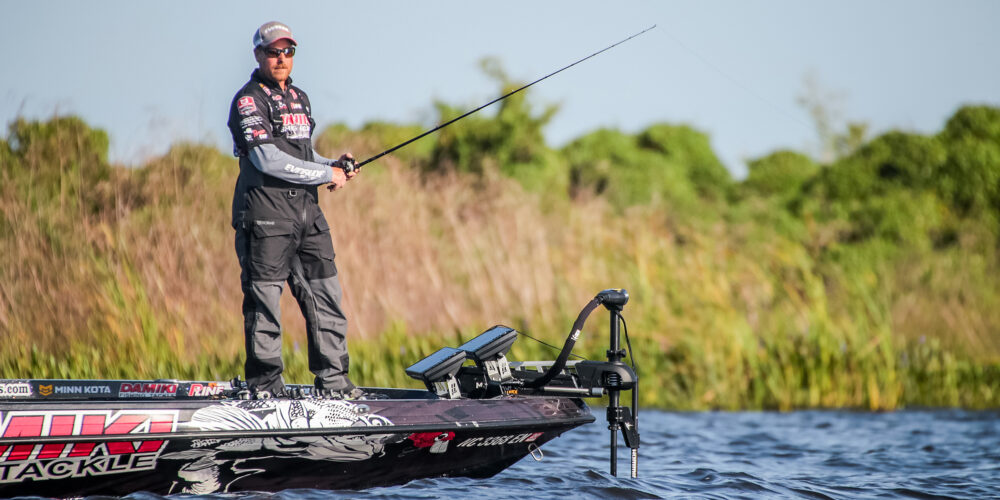Bryan Thrift’s Three Go-To Patterns for Fall Success

Bryan Thrift has made a career being a bass-fishing Dyson vacuum: When he comes through an area, it’s almost certain he will catch just about every bass it has to offer. So, during the fall, when folks are raking leaves or out hunting, Thrift enjoys employing his vacuum-esque skillset on distinct patterns he feels you can mimic almost anywhere bass live in North America.
“The first thing I look for in the fall, in lakes that have already turned over, are the backs of creeks and pockets,” Thrift advises. “That’s the number one thing I look for. Now, add bait being corralled back there by a school of bass, and it can be such fun fishing. It happens all throughout the country in fall.”
Not all creeks and pockets are created equal, though.
“The biggest factor is the pocket needs a naturally flowing creek that brings fresh, oxygenated water into it,” Thrift says. “Also, it always helps to have expansive flats with a channel running throughout. The channel acts as kind of a road for the fish to run through to the laydowns, rockpiles, or other cover they are using on it.
“In addition to the channel, I want to see bait on my electronics in that 10- to 15-foot range, but then I also want to see bait flipping on the surface in the shallows in the 5-foot depths too. Seeing all that bait ensures that there will be bass feeding at sometime.”
Thrift’s Go-To Fall Baits
Thrift favors shad-imitating colors for the pocket and creek pattern during the fall, but employs a little subtlety in color selection, depending on water clarity
“I stick with shad-colored baits, but the way I differentiate which version of shad color is solely based on color water,” he says. “If there’s 3 feet or more of visibility in the water, I go with a toned down, more translucent or pearl shad color. If visibility is 2 feet or less, I’ll go with the brighter white shad pattern.”
“My go-to is a buzzbait, or a Damiki Rambler topwater, as long as the water is in the 60-degree range. Fishing the same area, but with the water in the 50s, I’ll throw a Damiki Tremor lipless crankbait. It’s really overlooked and thought of as a spring bait. It works great, it’s the right size to mimic the bait, has a nice tight wobble, and it’s not really loud or obtrusive.”
The time of day doesn’t alway matter during the fall, though Thrift notes that bass are more surface orientated in evening around 4:00 pm until dark.
All Docks Are Not Created Equal
Docks are Thrift’s second option when fishing fall bass.
“Boat docks are overlooked in fall quite often,” he says. “A lot of fish live on docks, and it seems like during the fall, big fish are on brushpiles by the docks, feeding on crappie that start moving into the shallows on brush and docks. I believe that some of the true giants in a lake feed heavily on crappie.”
But Thrift is quick to point out that all boat docks are not created equal.
“I don’t want to fish any and every dock,” Thrift confirms. “I look for boat docks located on or near a channel swing, with added structure, like a brushpile or rock vein. In the fall, shade doesn’t play as big of a factor as does in the spring. But the dock needs that little bit of added structure to hold bait and provide ambush points for bass.”
Thrift is usually throwing a ½-ounce Damiki Mamba Jig when he’s working docks, and alternates between trailers depending on the rate of fall he wants to use. For a slower fall, he’ll use the Damiki Knock Out, and for a faster descent, a slimmer trailer like a Super Chunk Jr.
“When it comes to fishing docks with jigs, a lot depends on water clarity again,” Thrift says. “But I’m typically fishing them a little deeper, and if the water clarity gives 3 or 4 feet of visibility, I always use a version of green pumpkin. If the jig looks good with a green pumpkin trailer, it’ll catch them.”
Fall Option Number Three: Spinnerbaits
If the weather outside is cloudy and windy, burn your blade for bass.
“Now, this is one technique that’s weather dependent, whereas (creeks and docks) work day in and day out during the fall on a relatively clear body of water: I’m talking about burning a spinnerbait,” Thrift says. “During the fall, you can catch bass using this technique for about the first 30 minutes of daylight, but if you have a cloudy and windy day, it can stay productive all day.
“I use a ¾-ounce Damiki TOT spinnerbait. Snow Shad is my go-to color. It’s a translucent smokey color. The TOT spinnerbait wire has a small diameter and thinner blade. It won’t blowout on the surface when you’re burning it back. Get on the bank like it’s spring and fish parallel. Burn that spinnerbait past laydowns, rock banks, any transition location- typical prespawn type cover with some deeper water nearby.
“It’s one of the beautiful things about fishing. The bass are always doing what you don’t think they’re supposed to be doing.”